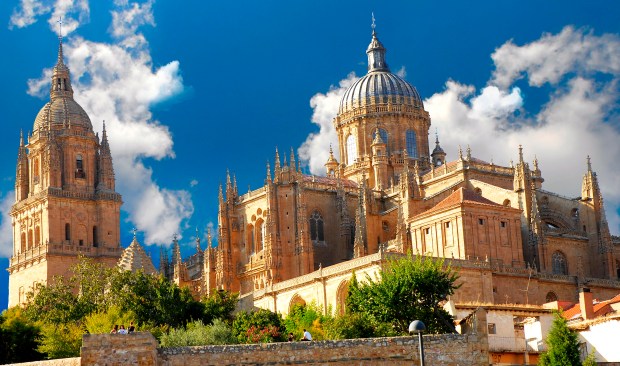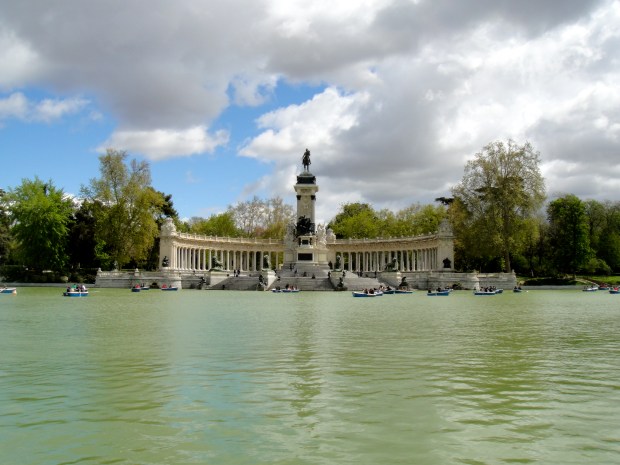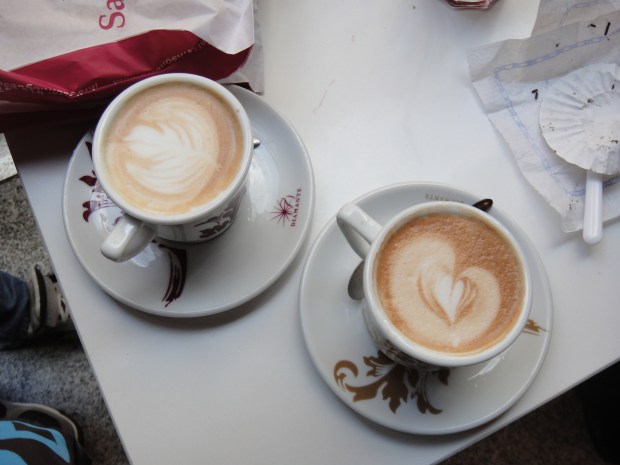Madrid-Salamanca Part I: Silk-scarf Chagall’s and perfect palmeras – Thyssen, Prado and a well-needed Retiro

I have got the travel bug again, a bug which generally manifests itself in an urgent need to revisit the country of my parallel existence, Spain. There are a great deal of cities which I have left as yet unexplored on the Iberian Peninsula, but following the recent recommendation of a good friend, whose excellent taste for all things art historical is like the unwavering role of Vogue as a navigator through the undulations of fashion, I settled my sights on a city renowned for its university, its unrivalled and elaborate baroque architecture, and an all-over golden glow emanating from its consistent use of the local “Villamayor” sun-dappled sandstone: the City of Salamanca.
Salamanca, named European Capital of Culture in 2002 and a UNESCO world-heritage site in 1988, is an amber-coloured gem set deep within the rocky central plains of the Castilla y Leon region of Spain. Despite its renown, the city has no airport, and consequently a visit to Madrid was first deemed necessary (you can also fly to nearby Valladolid and take a train to Salamanca from there). We decided to take advantage of Madrid as a channel to Castilla, staying two nights in the Vincci Soho hotel on the Calle Prado within easy reach of the Madrid artistic tripartite: the Thyssen-Bornemisza; the Prado and the Reina Sofia. It’s my fifth time in Madrid, but who can turn down the opportunity to drop in on some of the greatest masterpieces in all the world?
Upon waking in our spacious room complete with two balconies, one looking down to the Thyssen and the other angled towards the lively Plaza Santa Ana (we arrived late the previous night after a delayed flight and an even longer wait for luggage at Madrid airport) we headed enthusiastically into gallery land, stopping only for a sinful coffee at Starbucks (I know, and this coming from me, opponent of cafe chains – but you try getting a humble coffee in a zone of parks, monuments and gallery cafes).
First stop was the Thyssen-Bornemisza, a vast gallery which houses the collections of two respective generations of the Thyssen-Bornemisza family, the largest of which was acquired by the Spanish state in 1993. A temporary show offered a retrospective look at the career of Marc Chagall. I was pleased about this, having only previously seen odd pieces by the Russian artist, and having gazed unknowingly at one of his designs throughout my youth when I admired the bloody red window which brightens up one facade of Chichester Cathedral in my home county of West Sussex.
The show started fairly well. Chagall experimented with the cubist genre before moving into a more uniquely multi-coloured abstractive approach, all the while retaining figures who are often suspended randomly upon a two-dimensional backcloth. I liked some of his early works. His painting of a crucifixion (“Golgotha”) upon a background of tumultuous green showed originality and a powerful sense of drama (despite being Jewish, Chagall made recurrent references to the crucifixion in his work which he saw as a symbol of persecution of the Jews). I was also attracted by his works illustrating his home town of Vitebsk, with their subdued colour palette. Thereafter I wasn’t so impressed. His works became fairly repetitive and quite cartoony. His paintings featured the same symbols obsessively: badly painted livestock and horses playing the fiddle, embracing couples, and haphazardly executed flowers, all set against a vivid blue or red background. For me, his works resemble the kind of tacky silk scarves you find in arts and craft fairs. Try as I might, I really struggled to connect with his works. This connection was also made slightly harder by virtue of Thyssen’s bizarre decision to split the exhibition between two sites, so that for the second half we had to traipse halfway across central Madrid to the Caja Fundacion.
Having done the Chagall, and the rest of Thyssen’s collection, we emerged into a sunny Madrid and feeling full of the joys of Spring, headed to the Retiro park for lunch. Our admiration of these beautifully laid out public gardens including a massive pleasure lake framed by the arms of a vast colonnaded palace was however rudely interrupted by the passing of a rainstorm and accompanying Icelandic winds which swiftly turned Spring into mid-Winter in a heartbeat. Our shelter under a big pine tree proved rather fruitless, to which our damp visage later played testament, but luckily it really was a passing shower. With the sun out again, we and a number of other tourists emerged from our hiding places in the greenery like fairies called to the command of Titania in A Midsummer Night’s Dream, and we headed for the Prado.
The Prado is a must for any art lover. The collection is so vast and the highlights so important and and wide-reaching that it frankly tramples the Louvre’s Mona Lisa-centred collection and blows the UK out of the water. Here you find Velazquez’s Las Meninas as well as a huge number of important highlights from his oeuvre: his royal portraits, “buffoons”, crucifixion and so on. Just a few galleries away are some stunning works by my favourite of the old masters: El Greco, a man whose works were so startlingly modern for his day that they wouldn’t look out of place down the road in the Reina Sofia with the Picasso’s. Then there are Goya’s chilling black paintings, and his 2nd and 3rd of May 1808 masterpieces, Bosch’s Garden of Earthly Delights, and vast canvases by Rubens and Van Dyke. But asides from the priceless masterpieces, there are also wonderful examples of 19th century art by lesser known artists, and huge historical masterpieces such as this one, The Execution of Torrijos and His Companions on the Beach at Malaga by Antonio Gisbert, a painting which is so big that it could easily eclipse the average family home.

Antonio Gisbert, The Execution of Torrijos and His Companions on the Beach at Malaga (1887-88) (390cm x 600cm) Prado Gallery, Madrid
Understandably exhausted by the breadth of works on show, we retreated to our hotel for a well-earned rest before heading out, into the evening sun, to explore the livelier side of Madrid. We particularly enjoyed a visit to the bustling Mercado San Miguel, where locals and tourists alike gather to sample seafood delicacies, wines, tapas and pastries. Being as ever the purveyors of all things sweet, we settled for a creamy coffee and two freshly baked palmeras (otherwise known as palmiers or “elephant ears”). Now that is what I call a rounded day of cultural appreciation.
¡Hasta mañana!
Trackbacks & Pingbacks
- Madrid-Salamanca Part II: Whose Plaza Mayor is mejor? | The Daily Norm
- Madrid – My photographs | The Daily Norm
- Madrid-Salamanca Part III: A frog, an astronaut, and a very cold ice cream | The Daily Norm
- Madrid-Salamanca Part IV: Not so new – Art nouveau and the towers of the Cathedral Nueva | The Daily Norm
- Salamanca – My photographs | The Daily Norm
- Madrid – Restaurant focus: Va de Baco and Ølsen | The Daily Norm
- Salamanca – Restaurant Focus: El Alquimista and La Cocina de Toño | The Daily Norm
- Salamanca: My Painting – Homage to a sandstone city in oil on canvas | The Daily Norm














































I went to Salamana twice to visit my sister when she was there. Such a stunning and charming place that i really loved! Didn’t get to spend any time in Madrid unfortunately but drove across into Portugal until we hit the beach. Some beautiful little towns on the way there. So jealous of all your trips. I’m stuck in Canada with no where to go!
My goodness don’t say that! I’m worried about you out there in Canada… can’t you move back soon? The UK’s proximity to Europe is clearly unrivalled. And we miss you! xx